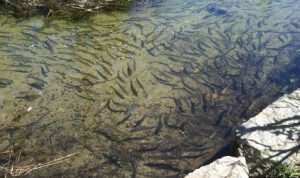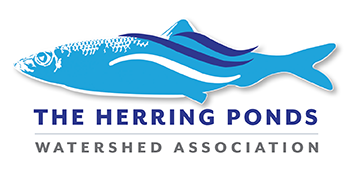Citizen Science Volunteers Needed for Fish Count
 By Ramona Krogman
By Ramona Krogman
The winter of 2023 has been a roller coaster ride! From high winds with cold temperatures to rain and unseasonable warmth. As March rolls in it is time to plan for spring. Spring brings the return of river herring to Great and Little Herring Ponds. River herring are a part of the history of Massachusetts. They provided a source of nutrients for Native Americans and newly arrived settlers.
We need your help to document the number of fish returning to our ponds. A count takes 15 minutes once or twice a week during the months of April and May. Only 10 minutes to count and a few minutes to log your data. A small commitment to generate data on an important species.
River herring play a vital role in the North Atlantic ecosystem, providing food for tuna, cod, striped bass, seabirds, herons, dolphins, and whales. Recovery of their populations helps stabilize coastal fisheries. River herring provide a nutrient transfer link between the ocean and streams.
River herring species include Alewife and Blueback herring. They are an anadromous species, meaning they spend most of their lives at sea but return to fresh water to spawn. They lay their eggs in their natal pond or stream, meaning they return each season to the water where they hatched. Individuals complete the cycle several times in their lives. The young hatch and grow into fingerlings before following their parents out to sea.
Alewife river herring begin to move up the Cape Cod Canal and into the fish ladder located along Route 6 as the water temperature reaches 51°F. Alewives prefer the quieter water of Great and Little Herring Ponds. Spawning for Blueback herring is initiated as the water reaches 57 °F. They prefer to spawn in fast-moving waters such as the Monument (Herring) River. River herring populations declined sharply during the 1980’s due to pressures on habitat and overfishing.
Counts like the HPWA count provide data for the Massachusetts Division of Marine Fisheries to support efforts to protect the river herring. Our herring move under Route 6 and through an electronic fish counter, then into the Monument River. Those traveling into Great and Little Herring Ponds continue up the river past our counters. Herring typically come through in groups. At the height of the run, pulses of several hundred can come through in a single count.
HPWA counters aid in the collection of valuable data to protect the overall well-being of the river herring in our pond. They also raise awareness of pond ecology with neighbors living in our watershed.
Be a Citizen Scientist! If you would like to volunteer as a counter in April and May, email Ramona Krogman at ramiek99@hotmail.com . Training will be available via Zoom and in person.

Comments
Citizen Science Volunteers Needed for Fish Count — No Comments
HTML tags allowed in your comment: <a href="" title=""> <abbr title=""> <acronym title=""> <b> <blockquote cite=""> <cite> <code> <del datetime=""> <em> <i> <q cite=""> <s> <strike> <strong>